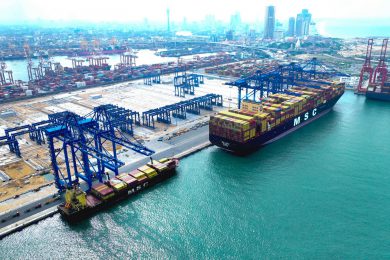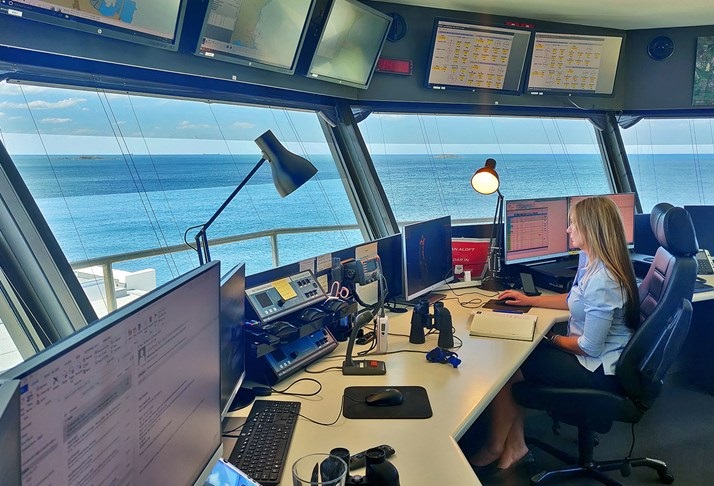We gathered all your AIS-related questions, and we’re excited to finally answer them!
by Sotiria Kontopoulou
What is AIS?
AIS is an automated, autonomous tracking system that tracks the location of vessels anywhere they are in the world.
What is an AIS system on a boat?
AIS is extensively used in the maritime world for the exchange of navigational information between AIS-equipped terminals.
What does AIS stand for in Marine?
AIS stands for Automatic Identification System and it refers to the automated, autonomous tracking system which is used to track the location of ships around the globe.
Why do ships need AIS onboard?
AIS is an extremely useful navigational aid on board a vessel that allows the crew to see others around them and also to be seen independent of weather conditions. It can also provide more information about a nearby contact like the vessel’s name, MMSI, dimensions, load status, etc.
Do military ships use AIS?
Yes! Naval vessels use an enriched capability variant of the classic AIS called W-AIS. This provides all the classic AIS functionality plus switching on/off, on the fly identity alteration (MMSI), on-demand self-position skew, encryption, etc.
What vessels are required to have AIS?
If you own a vessel over 300 gross tons or a passenger ship of any size, the IMO Convention for the Safety Of Life At Sea (SOLAS) Regulation V/19.2.4 requires that you operate AIS Class A onboard at all times – unless there are valid security reasons to turn it off, temporarily.
Can ships turn off AIS?
Any vessel carrying an Automatic Identification System can turn off the broadcast and the reasons why they may do so vary; what the changes in a vessel’s AIS broadcast mean can not be identified at all times as these may be a result of both licit necessary actions and even illicit activities at sea.
How do you turn off AIS?
An obvious way is to just kill the main and the auxiliary power to the unit.
Another option that many manufacturers provide is to disable self-reporting while still receiving AIS transmissions from others.
Why do ships turn off AIS?
This operation mode is often called “Silent mode” and is designed to be used mainly while sailing into dangerous waters (e.g. piracy infested areas).
Unfortunately, this capability is very often used when the vessel participates in illegal activities and is the main reason “Dark Vessels” (undetected by the AIS network) exist.
How do you test an AIS transponder?
Almost all AIS transponders from reputable & established manufacturers provide onboard self-check routines that validate the proper function of all the subsystems. If a fault is detected, the unit must be further checked by an authorized technician with the proper test equipment.
When can AIS be switched off?
According to IMO, AIS should always be on when vessels are underway or anchored for increased visibility and safety reasons.
Only under one condition could AIS be switched off, and this is in imminent danger and only when the Captain of the ship is certain that the continuous signal broadcast compromises the safety and security of their ship. A report including the actions taken as well as the reason for deciding to switch off AIS to the competent authority should always follow and be saved in the ship’s logbook. When the threat is not imminent anymore, the Captain should switch AIS back on right away.
What are the limitations of AIS?
AIS was conceived around 1996 and became operational in 2002. Back then, concepts like IoT, cybersecurity, cheap & accessible SDR (Software Defined Radio), large-scale satellite constellation deployments, etc. were either non-existent or in their infancy.
As a result, AIS was never built with data security or satellite reception capability in mind. In fact, these 2 are its most serious deficiencies; lack of data encryption & the limitations of the protocol for SAT-AIS.
What is the basic principle of AIS?
AIS in principle is a navigational aid alongside RADAR. That was its intended purpose when it was first conceived.
However, AIS data on large scale through disruptive technologies (like MarineTraffic) can become much more than that; it can become intelligence in the digital maritime domain.
What is the difference between AIS Class A and B?
Class A transceivers are designed for commercial vessels above 300GT while Class B is designed for leisure, recreational & small fishing vessels.
Class B transceivers are cheaper, have fewer interfaces, and have less transmitter power than Class A.
Additionally, Class B transceivers are designed to always give transmission slot reservation priority over Class A. This actually means that in a congested area, Class B transceivers will always wait for all Class A transceivers in the area to transmit their payload and then reserve a timeslot for transmission.
What is the range of AIS?
If an external antenna is placed 15 metres above sea level, the AIS-receiving station receives the AIS information from all AIS-equipped vessels which sail within a range of 15-20 NM around it; which is the output of a Class-A transponder.
Of course, if the stations are located at a higher altitude, this may extend the range up to 40-60 NM depending on factors such as elevation, antenna type, obstacles around the antenna, and weather conditions.
The most important factor for an efficient reception is the elevation of the base station antenna; the higher the antenna is placed, the better reception will be achieved.
The range is also subject to humidity in the area where the receiver is placed too. More humidity translates into poorer coverage in the area however this is still dependent on the type of the transponder as well. For instance, Class A receivers are more powerful than Class B and are less affected by humidity levels.
What is the difference between AIS and radar?
Both AIS & RADAR are navigational aids crucial to safe navigation in modern vessels.
RADAR predates AIS as a concept and stands for Radio Detection and Ranging. As the name implies the system uses radio waves to detect contacts and their distance from the vessel by measuring the time it takes for an echo to return to the antenna and the signal-bearing. As a detection method is very robust and direct meaning, it has a superior resolution and lower latency than AIS.
AIS however is an indirect detection method that relies on the other vessel to have its transponder active. It contains a plethora of information regarding the detected vessel that RADAR cannot measure like identity, navigational status, load status etc.
These 2 systems work extremely well together, and they complete the synthetic picture of a vessel’s surroundings.
What is the power output of Class B AIS giving a range of 8/10 miles?
Class B transceivers come in 3 flavours with respect to their output RF power; 2W, 5W & 12W. Under normal conditions, a 10nm range can be achieved with the lowest power setting (2W). If the RF propagation conditions are bad, then 5W may be required to achieve the same range.
What are the types of AIS?
Onboard vessels, the types of AIS are two:
- Class A
- Class B
However, there are even more types regarding stations of the system ie when we talk about aircraft for example, or other non-shipborne related stations, self-contained Search & rescue transmitters more widely known as SART, etc.
Is it possible to connect GPS with the AIS?
It is not only possible, but it is also essential! AIS transponders have their own GPS receivers built-in (separate from the vessel’s receiver) in order to acquire the vessel’s position and prepare the self-position report that will be transmitted to others via AIS. GPS is very deeply embedded in the AIS system. It is also the only known attack vector for AIS spoofing.
How do I get AIS data?
Regarding a vessel’s position, the following data: Longitude (LON), Latitude (LAT), Vessel MMSI, Status, Course & Speed, Heading, Draught, Timestamp (UTC) as well as specific data such as Port Call Arrivals and/ or Departures, Port Name, Vessel MMS, Timestamp (UTC), can be accessed here. If you need even more advanced information and access to exclusive data sets, click here.
What is the purpose of annual testing of AIS?
AIS transponder is subject to regular inspections.
What is the dynamic information transmitted by AIS?
The dynamic information transmitted by AIS from vessels equipped with Class A transponders includes the following:
- Maritime Mobile Service Identity number (MMSI) – a unique identification number for each vessel station (the vessel’s flag can also be deducted from it)
- AIS Navigational Status – manually set by the vessel’s crew Related reading: What is the significance of the AIS Navigational Status Values?
- Rate of Turn – right or left (0 to 720 degrees per minute)
- Speed over Ground – 0 to 102 knots (0.1-knot resolution)
- Position Coordinates (latitude/longitude – up to 0.0001 minutes accuracy)
- Course over Ground – up to 0.1° relative to true north
- Heading – 0 to 359 degrees
- Bearing at own position – 0 to 359 degrees
- UTC seconds – the seconds’ field of the UTC time when the subject data packet was generated.
All the above-listed dynamic information is automatically transmitted every 2 to 10 seconds depending on the vessel’s speed and course while underway, and every 6 minutes while the vessel is anchored.
What is an AIS API?
An AIS API enables the integration of AIS-related data into your existing software.
Can you track a cargo ship?
Yes, using the IMO number or the name of the vessel carrying your cargo, you can enter this with an AIS maritime tracking intelligence provider, like MarineTraffic, to track the vessel’s progress at sea.
Related reading: Cargo tracking in five steps
What are AIS frequencies?
The frequencies are: 161,975Mhz & 162,025MHz.
What does AIS do?
AIS allows for static and dynamic vessel information to be electronically exchanged between AIS-receiving stations; these can be onboard, ashore (what we call terrestrial-based) or even satellite-based.
When was AIS introduced?
Since December 2004, the International Maritime Organisation (IMO) has required all passenger and commercial vessels over 299 Gross Tonnage (GT) that travel internationally, to carry a Class A AIS transponder aboard to transmit and receive AIS data. Smaller vessels can also be equipped with a Class B AIS transponder.
Why was AIS first introduced?
The AIS arrival to the maritime industry brought a great impact on shipping, as it helped to increase:
- safety at sea, with collision avoidance and Search And Rescue operations globally.
- transparency, allowing everyone to operate more safely and efficiently.
- accountability, as all actions from crew to shipping executives, are under greater scrutiny providing more accurate information.
- data-driven decisions, as the gathering of positional data from all commercial vessels, helps create an unbiased picture of global maritime activity, which raises awareness and enables more sectors of the maritime domain to make decisions based on near real-time data.
The original purpose of AIS was solely collision avoidance but many other applications have since developed and continue to be developed.
How does AIS work?
For many parts of the world, terrestrial receivers are the norm, however, especially over open oceans and beyond the reach of terrestrial-based AIS systems, the Satellite receivers come to the rescue.
The AIS-transmitted information that vessels periodically send is being picked up by AIS-receiving stations. AIS transponders (on vessels) also include a GPS receiver that collects the current position and movement details of the vessel. Such dynamic details along with other static information provided by the vessel’s crew are automatically broadcasted at regular intervals.
Periodic AIS-data information can also be received by other in-range vessels or base stations. Then, with the use of special software, it can be processed and depicted on chart plotters or on computers (for example, on MarineTraffic Live Map).
Sotiria Kontopoulou is a Content Writer at MarineTraffic where this piece first appeared.























